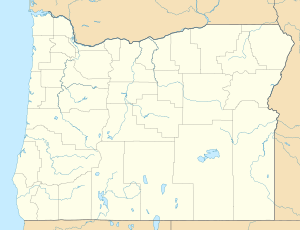Tanner Creek facts for kids
Quick facts for kids Tanner Creek |
|
|---|---|
|
Location of the mouth of Tanner Creek in Oregon
|
|
| Country | United States |
| State | Oregon |
| County, city | Multnomah County, Portland |
| Physical characteristics | |
| Main source | Tualatin Mountains (West Hills) 45°30′32″N 122°43′55″W / 45.50889°N 122.73194°W |
| River mouth | Couch Lake (Willamette River) Oregon 45°31′09″N 122°40′54″W / 45.51917°N 122.68167°W |
Tanner Creek is a small stream in Portland, Oregon. It flows into the Willamette River. This creek is special because it mostly flows underground today.
It starts in the Tualatin Mountains, also known as the West Hills. In the 1800s, Tanner Creek flowed openly through Portland. It went past where Providence Park is now. Then it emptied into a shallow area called Couch Lake. This lake was in what is now the Pearl District.
Later, the city of Portland changed the creek's path. They moved it into underground pipes. They also filled in the old creek beds. This made flat land for buildings. Today, Tanner Creek is hidden. It flows through a large pipe. This pipe goes directly into the Willamette River. You can find its end near the Broadway Bridge.
Contents
How Tanner Creek Got Its Name
Daniel Lownsdale was one of Portland's first settlers. He helped found the city. In 1845, he built a tannery next to the creek. A tannery is a place where animal hides are turned into leather. The creek was named after this tannery.
Old Roads and Lakes
Canyon Road was very important for early Portland. It was built along the canyon where Tanner Creek flowed. This road opened in 1849. It connected Portland to the Tualatin Valley. Daniel Lownsdale helped survey an improved version of the road.
Couch Lake was named after John H. Couch. He was another early settler and city founder. Couch built his home on the west side of the lake.
Tanner Creek on the Surface
The creek's beginning is in the Sylvan–Highlands neighborhood. This area is in the West Hills, west of downtown Portland. The creek flowed down a canyon. Today, Southwest Jefferson Street and Canyon Road follow this old canyon.
The creek continued across the area where Providence Park is now. It then flowed into a deep ravine. This ravine was about 50 feet (15 meters) deep in some places. It was also as wide as several city blocks. The Vista Bridge in the Goose Hollow neighborhood crosses a part of this old ravine. Markers on the pavement near Providence Park show where the creek used to flow.
Tanner Creek used to flow into Couch Lake. This lake was near today's Union Station. The lake was about 15 feet (4.6 meters) deep. It covered an area of 22 city blocks. In 1888, a company bought the lake. They started filling it with sand and ship ballast. This made the land flat for building.
Tanner Creek Underground
Between 1887 and 1891, Portland built a large sewer system. This system was designed to carry Tanner Creek's water. It also carried storm runoff and sewage from the West Hills. This sewer was about 6 feet (1.8 meters) wide. At the time, it was one of the biggest sewers the city had ever built.
Later, around 1904, a part of the sewer collapsed. This caused flooding in nearby areas. The city had to repair and rebuild parts of it. The main Tanner Creek sewer pipe ran from Southwest Taylor Street to the river. It ended near Front Avenue and Pettygrove Street.
Tanner Creek Today
Tanner Springs Park is a special place that remembers the creek. It is located at Northwest 10th Avenue and Marshall Street. The park opened in 2003. It is an "urban waterscape" built on land that was filled in. This land is 20 feet (6.1 meters) higher than the old lake surface. The wetlands in the park are not directly connected to Tanner Creek. They mostly use recycled rainwater.
In 2006, the city finished a new pipeline. This pipe took Tanner Creek's water out of the old sewer system. Now, the creek water flows directly into the Willamette River. This was part of a bigger project. The goal was to stop sewage from flowing into the river during storms. The new pipe lets the creek out about a quarter-mile downstream from the Broadway Bridge. This is about 11.4 miles (18.3 kilometers) upstream from where the Willamette River meets the Columbia River.


